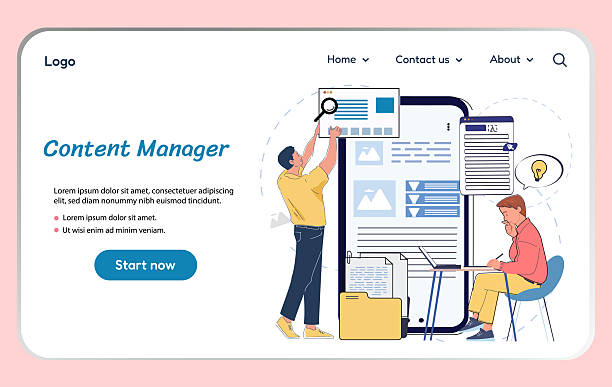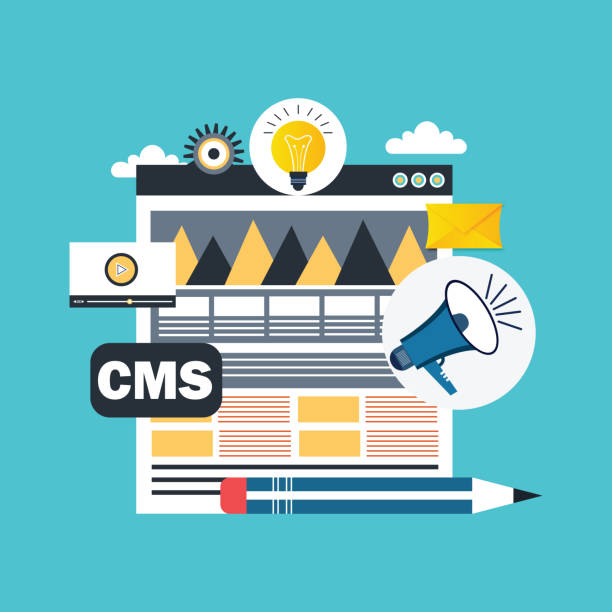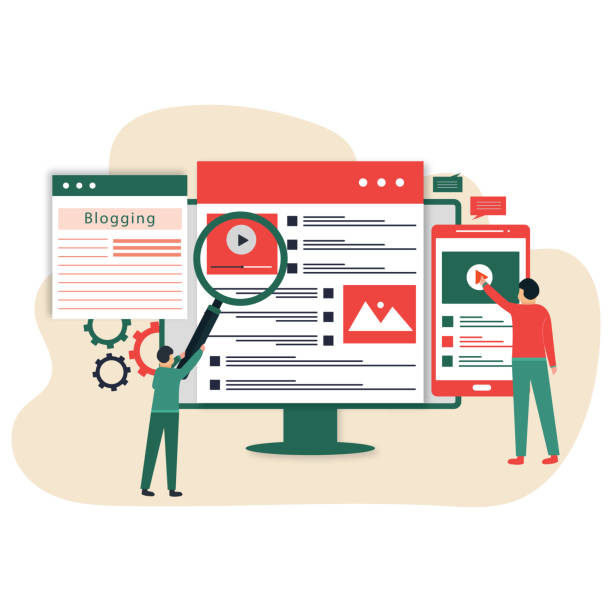The Importance of Fast Website Design in Today’s Digital World

In this era where speed is paramount, fast website design is not just an advantage, but a necessity for every online business.
Today’s users are more impatient than ever and expect websites to load in a fraction of a second.
Numerous studies have shown that every second of delay in page loading can significantly and negatively impact conversion rates, user engagement, and even the site’s ranking in search engines.
This issue is not limited to user experience alone; Google and other search engines view site speed as one of the key ranking factors. Therefore, if you are looking for a successful online presence, investing in website speed optimization is vital.
Ignoring this can lead to the loss of potential customers and reduced revenue.
How much does losing business leads due to an unprofessional website cost you? With professional corporate website design by Rasawab, solve this problem forever!
✅ Increase credibility and trust of potential customers
✅ Easier attraction of new business leads
⚡ Get a free consultation now!
The Impact of Site Speed on User Experience and SEO

Website loading speed is directly linked to user experience (UX).
A slow website frustrates users and makes them leave without hesitation.
This not only leads to decreased customer satisfaction but also sends negative signals to search engines.
Suppose you have an online store; if product pages take too long to load, customers will easily turn to your competitor’s site.
From an SEO perspective, search engines like Google prefer high-speed websites.
Google’s algorithms consider page speed as an important ranking factor, as their goal is to provide the best possible experience for users.
Therefore, a faster website not only achieves a better ranking in search results but also has a lower bounce rate and increases user engagement.
Fast website design means investing in the future of your business.
Key Factors Affecting Website Design Speed

To achieve fast website design, it is essential to understand the factors affecting its speed.
These factors include code optimization, image compression, and the use of appropriate caching methods.
Excessive and unnecessary code, high-volume images, and lack of caching can severely reduce site loading speed. Also, choosing a suitable host and using a Content Delivery Network (CDN) play a significant role in improving speed.
A powerful host close to your audience can minimize server response time.
Additionally, using optimized web fonts, minimizing HTTP requests, and utilizing optimized CSS and JavaScript all contribute to improving website performance.
To better understand these factors, refer to the table below:
| Factor | Impact on Speed | Solution |
|---|---|---|
| Image Size | Drastic reduction in loading speed | Compression, using next-gen formats (WebP) |
| Unoptimized CSS/JS code | Increased page rendering time | Minification, file concatenation |
| Inappropriate host selection | High server response time | Choosing a high-speed and reputable host |
| Lack of caching | Reloading all content on every visit | Implementing browser and server caching |
By focusing on these factors, we can achieve high-speed website design that not only satisfies users but also helps improve our position in search engines.
Technical Optimization Techniques to Increase Site Speed

To achieve speed-optimized website design, we need to employ technical techniques applied to the website’s infrastructure.
One of the most important is code Minification; removing white spaces, comments, and extra characters from CSS, JavaScript, and HTML files reduces their size and consequently speeds up loading. Another is image compression using formats like WebP, which maintains quality while significantly reducing file size.
Using Lazy Loading techniques for images and videos is also very effective; this way, content is only loaded when the user needs it and enters the relevant section of the page.
Additionally, database optimization, reducing HTTP requests by concatenating files, and using GZIP compression for data transfer are all measures that contribute to a super-fast website.
These specialized approaches form the foundation of any successful strategy for improving site speed.
Are you tired of your company website not meeting your expectations? With Rasawab, design a professional website that truly represents your business.
✅ Increase the attraction of new customers and sales leads
✅ Enhance your brand’s credibility and trust with your audience
⚡ Get a free website design consultation!
The Role of Host and Server in Fast Website Design

Choosing the right host and server is the backbone of high-speed website design.
Even with the best software optimizations, a weak host or a server lacking sufficient resources can render your efforts ineffective.
Server Response Time is a critical metric that must be considered.
The lower this time, the faster your site begins to load. Dedicated or VPS hosts generally offer more speed and resources than shared hosts, but also come with a higher cost.
The server’s location is also very important; if your audience is primarily in a specific region, choosing a server close to them can help reduce latency.
Furthermore, using the HTTP/2 protocol instead of HTTP/1.1, which offers features like multiplexing and header compression, can significantly improve data transfer speed between the server and the user’s browser.
Quality web hosting is an investment in achieving a fast and efficient website.
Using CDN to Improve Speed and Global Accessibility

A Content Delivery Network (CDN) is a powerful tool for increasing speed and global accessibility in fast website design.
A CDN is a collection of servers in various geographical locations that store copies of your website’s static content (such as images, CSS, and JavaScript files).
When a user visits your website, the content is delivered from the nearest CDN server to them, not from the origin server.
This significantly reduces loading time, especially for users far from the origin server. In addition to increasing speed, a CDN also provides security and reliability benefits.
In the event of an issue with the origin server or a DDoS attack, the CDN can manage traffic and keep your site online.
Many reputable CDN providers like Cloudflare or Akamai offer a variety of services that can significantly help increase your site’s speed.
This method is an effective way to guarantee high speed for all users worldwide.
Mobile-First Design and its Importance for Speed

With the increasing use of mobile devices for internet access, the concept of Mobile-First Design and its impact on high-speed website design has become increasingly important.
This approach means prioritizing the design and optimization of a website for mobile devices and then scaling it for larger screens.
In mobile-first design, minimizing content size, using images optimized for mobile, and removing unnecessary elements that can slow down loading are of high importance.
Google also places special emphasis on sites that provide a good user experience on mobile and includes this in its search ranking.
| Mobile-First Factor | Impact on Speed | Why It Matters? |
|---|---|---|
| Responsive Images | Faster loading of images optimized for screen size | Prevents loading large images on small devices |
| Light and Clean Code | Reduces processing and rendering time | Mobile devices have less processing power |
| Focus on Core Content | Removes unnecessary elements and reduces page size | Provides a better user experience on small screens |
A responsive website that is well-optimized for mobile not only provides a better user experience but also achieves a higher ranking in mobile search results.
This approach ensures that your fast website design performs well on any device and meets the needs of mobile users.
Tools and Metrics for Measuring Site Speed

To ensure that your fast website design is truly fast, you need specific measurement tools and metrics.
Tools like Google PageSpeed Insights, GTmetrix, and Pingdom Tools help you evaluate your website’s performance.
These tools provide scores for your site’s speed on desktop and mobile and offer a list of recommendations for improvement.
Key metrics to pay attention to include: First Contentful Paint (FCP), Largest Contentful Paint (LCP), Cumulative Layout Shift (CLS), and Time to Interactive (TTI). FCP indicates the loading time of the first visible content, LCP measures the loading time of the largest content element, CLS evaluates the visual stability of the page, and TTI shows when the page is fully ready for user interaction.
Detailed analysis of these metrics helps you identify your website’s weaknesses and take action to improve them.
Website speed improvement is an ongoing process, and regular use of these tools for monitoring and optimization is essential.
Don’t have a corporate website yet and missing out on online opportunities? With professional corporate website design by Rasawab,
✅ Double your business credibility
✅ Attract new customers
⚡ Free consultation for your corporate website!
Common Website Design Mistakes That Lead to Slowness

In the pursuit of fast website design, some common mistakes can be major obstacles to achieving optimal speed.
One such mistake is the excessive use of unnecessary plugins and scripts. Every additional plugin or script adds to your website’s load and can reduce its speed.
Another mistake is loading images with inappropriate sizes and dimensions.
Many designers upload images directly from cameras or other sources without optimization, which severely impacts loading time.
The lack of caching and CDN is also a major mistake that can cause all content to be reloaded on every visit.
Additionally, choosing multiple and unnecessary web fonts or using heavy frameworks that are overkill for the project can contribute to website slowness.
Finally, neglecting to optimize CSS and JavaScript codes and leaving them uncompressed and full of white spaces can significantly lower page rendering speed.
To achieve a high-performance website, identifying and correcting these mistakes is crucial.
The Future of Fast Website Design and New Trends

The future of fast website design is constantly evolving, with new trends emerging that aim to further increase website speed and efficiency.
One of these trends is the widespread use of Progressive Web Apps (PWAs), which offer a combination of the best features of the web and mobile applications. PWAs provide offline capabilities, Push Notifications, and incredibly fast loading speeds.
Another is the focus on Google’s Core Web Vitals, which gives more importance to user experience metrics (such as LCP, FID, and CLS) and encourages developers to pay special attention to these.
The use of WebAssembly to increase the execution speed of complex codes and Serverless technologies for infrastructure optimization are also significant trends.
Furthermore, optimization for 5G networks and future generations of the internet, and the use of artificial intelligence to predict and load content before the user needs it, are all moving towards faster and smoother web browsing.
These developments indicate that speed will remain one of the most important pillars of success in the web world, and web design specialists must constantly keep themselves updated with these changes.
Frequently Asked Questions
| Question | Answer |
|---|---|
| What is fast website design? | The process of building a website that loads quickly and provides a smooth user experience. |
| Why is website speed important? | Improved user experience, reduced bounce rate, increased conversion rates, and better search engine ranking (SEO). |
| What factors affect website speed? | Image size, number of HTTP requests, code optimization (HTML, CSS, JS), host speed, and browser cache. |
| How can website speed be improved? | Optimizing images, compressing files, using caching, choosing a suitable host, and reducing unnecessary plugins. |
| How do images affect website speed? | Large or improperly formatted images can significantly increase page load time. |
| What is the role of JavaScript and CSS in website speed? | Unoptimized code, large file sizes, or blocking execution can reduce page rendering speed. |
| How much does hosting affect website speed? | The speed and quality of the hosting server directly impact website response time and initial loading speed. |
| What tools are available to check website speed? | Google PageSpeed Insights, GTmetrix, Pingdom Tools are common tools. |
| What are the benefits of a fast website? | Greater user satisfaction, reduced bounce rate, increased time on site, and improved ranking in Google results (SEO). |
| What are common mistakes that slow down a website? | Using unoptimized images, bulky and disorganized coding, excessive use of plugins, and lack of caching. |
And other advertising services by Rasa Web Advertising Agency
- Smart Link Building: Designed for businesses seeking user engagement through customized user experience.
- Smart Sales Automation: A combination of creativity and technology to increase click-through rates through SEO-driven content strategy.
- Smart Website Development: A creative platform for enhancing user engagement with marketing automation.
- Smart Social Media: A professional solution for digital branding with a focus on optimizing key pages.
- Smart Digital Advertising: An innovative service to increase website traffic through precise audience targeting.
And over a hundred other services in internet advertising, advertising consulting, and organizational solutions
Internet Advertising | Advertising Strategy | Advertorials
Resources
Benefits of Fast Site Design for Your BusinessChoosing the Best CMS for Fast Website DesignThe Impact of Site Speed on SEO Improvement and Google RankingIntroducing the Best Tools for Fast Website Design
? For a leap in the digital world and to achieve great goals, Rasa Web Afarin Digital Marketing Agency is with you. If you are looking for professional services including personal website design and innovative marketing strategies, contact us to take your business to the top.
📍 Tehran, Mirdamad Street, next to Bank Markazi, Southern Kazeroon Alley, Ramin Alley, No. 6


